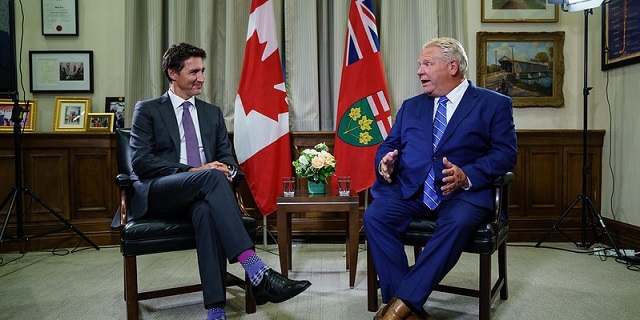Economy
The Good, the Bad and the Ugly—government budgets in 2024

From the Fraser Institute
By Grady Munro and Jake Fuss
Research showed the federal government could balance its budget in two years by slowing spending growth, yet instead the government doubled down and increased spending well past its previous estimates (against the wishes of Canadians)
This fiscal year, most provinces (and the federal government) demonstrated irresponsible fiscal management, although some were better than others. Therefore, in the words of the 1966 film starring Clint Eastwood, let’s discuss The Good, the Bad and the Ugly of Canadian government budgets in 2024.
Falling in the “good” category are Alberta and New Brunswick—the only two provinces planning to run a balanced budget in 2024/25, with Alberta forecasting a $367 million surplus and New Brunswick forecasting a $41 million surplus. Both provinces forecast surpluses until at least 2026/27, and expect net debt (total debt minus financial assets) as a share of the economy to decline in the years to come. However, what keeps these provinces from having a great budget is that both chose to further increase spending in the face of higher revenues, while failing to deliver much-needed tax relief.
Alberta in particular remains at risk of seeing future surpluses disappear, as the province relies on historically high resource revenues to fund its high spending. Should these volatile revenues decline, the province would return to operating at a deficit and growing its debt burden.
Provinces in the “bad” category include, but aren’t limited to, Saskatchewan and Newfoundland and Labrador. Largely due to quick growth in program spending that wipes out any revenue gains, both provinces expect deficits in 2023/24 and 2024/25 before planning to balance their budgets in 2025/26. The risks of unchecked spending growth are most salient in Saskatchewan, where just one year ago the province projected surpluses in both 2023/24 and 2024/25. And resulting from many years of deficits and debt accumulation, debt interest costs in Newfoundland and Labrador are expected to reach $2,123 per person in 2024/25, the highest in Canada.
Key governments among the “ugly” are the federal government, Ontario and British Columbia. Let’s take them one by one.
The federal government delivered a budget that continues the same failed approach that’s produced nearly a decade of stagnation in Canadian living standards. The Trudeau government plans to run a $39.8 billion deficit in 2024/25, followed by deficits of $20.0 billion or higher until at least 2028/29. Prior to the budget, research showed the federal government could balance its budget in two years by slowing spending growth, yet instead the government doubled down and increased spending well past its previous estimates (against the wishes of Canadians).
In addition to continuous spending increases and debt accumulation, the Trudeau government increased capital gains taxes on all businesses and many Canadians. Presented as a way to make the tax system more “fair” while generating $20 billion in revenue, in reality it is a harmful tax increase that is unlikely to generate the planned amount of revenues while simultaneously hindering economic growth and prosperity.
Similar to the federal government, in its 2024 budget Ontario’s Ford government simply doubled down on the same approach it’s taken in previous years. This “stay the course” fiscal plan added an average of $3.8 billion in new annual program spending (compared to last year’s budget) over the three years from 2023/24 to 2025/26. This new spending delays the province’s expected return to surpluses until 2026/27, and rather than run a $200 million surplus in 2024/25 the Ford government now plans to run a $9.8 billion deficit.
Importantly, the Ford government failed to deliver any meaningful tax relief for Ontarians in this budget, which once again breaks its promise to reduce personal income tax rates. Given that Ontarians face some of the highest personal income tax rates in North America, relief would help keep money in people’s pockets while also promoting economic growth.
Finally, the Eby government in B.C. tabled a budget that can be best described as a generational error in terms of the planned debt accumulation. The government plans to run a $7.9 billion deficit in 2024/25, followed by deficits of $7.8 billion and $6.4 billion in 2025/26 and 2026/27, respectively. In other words, the Eby government plans to run deficits in the coming years that are nearly as large or larger than those expected in Ontario, despite B.C. having a little over one-third of Ontario’s population.
Runaway spending drives these deficits and will contribute to a $55.1 billion (74.7 per cent) increase in provincial net debt from 2023/24 to 2026/27. This massive runup in debt will result in higher debt interest costs, which leaves less money available for services such as healthcare and education, or pro-growth tax relief for British Columbians.
By and large, governments across Canada demonstrated an irresponsible approach to managing public finances in this year’s round of budgets. While there were a couple of bright spots, the majority of provinces instead chose to increase spending, grow deficits and debt, and introduce little to no meaningful tax relief.
Authors:
Business
The world is no longer buying a transition to “something else” without defining what that is

From Resource Works
Even Bill Gates has shifted his stance, acknowledging that renewables alone can’t sustain a modern energy system — a reality still driving decisions in Canada.
You know the world has shifted when the New York Times, long a pulpit for hydrocarbon shame, starts publishing passages like this:
“Changes in policy matter, but the shift is also guided by the practical lessons that companies, governments and societies have learned about the difficulties in shifting from a world that runs on fossil fuels to something else.”
For years, the Times and much of the English-language press clung to a comfortable catechism: 100 per cent renewables were just around the corner, the end of hydrocarbons was preordained, and anyone who pointed to physics or economics was treated as some combination of backward, compromised or dangerous. But now the evidence has grown too big to ignore.
Across Europe, the retreat to energy realism is unmistakable. TotalEnergies is spending €5.1 billion on gas-fired plants in Britain, Italy, France, Ireland and the Netherlands because wind and solar can’t meet demand on their own. Shell is walking away from marquee offshore wind projects because the economics do not work. Italy and Greece are fast-tracking new gas development after years of prohibitions. Europe is rediscovering what modern economies require: firm, dispatchable power and secure domestic supply.
Meanwhile, Canada continues to tell itself a different story — and British Columbia most of all.
A new Fraser Institute study from Jock Finlayson and Karen Graham uses Statistics Canada’s own environmental goods and services and clean-tech accounts to quantify what Canada’s “clean economy” actually is, not what political speeches claim it could be.
The numbers are clear:
- The clean economy is 3.0–3.6 per cent of GDP.
- It accounts for about 2 per cent of employment.
- It has grown, but not faster than the economy overall.
- And its two largest components are hydroelectricity and waste management — mature legacy sectors, not shiny new clean-tech champions.
Despite $158 billion in federal “green” spending since 2014, Canada’s clean economy has not become the unstoppable engine of prosperity that policymakers have promised. Finlayson and Graham’s analysis casts serious doubt on the explosive-growth scenarios embraced by many politicians and commentators.
What’s striking is how mainstream this realism has become. Even Bill Gates, whose philanthropic footprint helped popularize much of the early clean-tech optimism, now says bluntly that the world had “no chance” of hitting its climate targets on the backs of renewables alone. His message is simple: the system is too big, the physics too hard, and the intermittency problem too unforgiving. Wind and solar will grow, but without firm power — nuclear, natural gas with carbon management, next-generation grid technologies — the transition collapses under its own weight. When the world’s most influential climate philanthropist says the story we’ve been sold isn’t technically possible, it should give policymakers pause.
And this is where the British Columbia story becomes astonishing.
It would be one thing if the result was dramatic reductions in emissions. The provincial government remains locked into the CleanBC architecture despite a record of consistently missed targets.
Since the staunchest defenders of CleanBC are not much bothered by the lack of meaningful GHG reductions, a reasonable person is left wondering whether there is some other motivation. Meanwhile, Victoria’s own numbers a couple of years ago projected an annual GDP hit of courtesy CleanBC of roughly $11 billion.
But here is the part that would make any objective analyst blink: when I recently flagged my interest in presenting my research to the CleanBC review panel, I discovered that the “reviewers” were, in fact, two of the key architects of the very program being reviewed. They were effectively asked to judge their own work.
You can imagine what they told us.
What I saw in that room was not an evidence-driven assessment of performance. It was a high-handed, fact-light defence of an ideological commitment. When we presented data showing that doctrinaire renewables-only thinking was failing both the economy and the environment, the reception was dismissive and incurious. It was the opposite of what a serious policy review looks like.
Meanwhile our hydro-based electricity system is facing historic challenges: long term droughts, soaring demand, unanswered questions about how growth will be powered especially in the crucial Northwest BC region, and continuing insistence that providers of reliable and relatively clean natural gas are to be frustrated at every turn.
Elsewhere, the price of change increasingly includes being able to explain how you were going to accomplish the things that you promise.
And yes — in some places it will take time for the tide of energy unreality to recede. But that doesn’t mean we shouldn’t be improving our systems, reducing emissions, and investing in technologies that genuinely work. It simply means we must stop pretending politics can overrule physics.
Europe has learned this lesson the hard way. Global energy companies are reorganizing around a 50-50 world of firm natural gas and renewables — the model many experts have been signalling for years. Even the New York Times now describes this shift with a note of astonishment.
British Columbia, meanwhile, remains committed to its own storyline even as the ground shifts beneath it. This isn’t about who wins the argument — it’s about government staying locked on its most basic duty: safeguarding the incomes and stability of the families who depend on a functioning energy system.
Resource Works News
Business
Brutal economic numbers need more course corrections from Ottawa

From the Fraser Institute
By Matthew Lau
Canada’s lagging productivity growth has been widely discussed, especially after Bank of Canada senior deputy governor Carolyn Rogers last year declared it “an emergency” and said “it’s time to break the glass.” The federal Liberal government, now entering its eleventh year in office, admitted in its recent budget that “productivity remains weak, limiting wage gains for workers.”
Numerous recent reports show just how weak Canada’s productivity has been. A recent study published by the Fraser Institute shows that since 2001, labour productivity has increased only 16.5 per cent in Canada vs. 54.7 per cent in the United States, with our underperformance especially notable after 2017. Weak business investment is a primary reason for Canada’s continued poor economic outcomes.
A recent McKinsey study provides worrying details about how the productivity crisis pervades almost all sectors of the economy. Relative to the U.S., our labour productivity underperforms in: mining, quarrying, and oil and gas extraction; construction; manufacturing; transportation and warehousing; retail trade; professional, scientific, and technical services; real estate and rental leasing; wholesale trade; finance and insurance; information and cultural industries; accommodation and food services; utilities; arts, entertainment and recreation; and administrative and support, waste management and remediation services.
Canada has relatively higher labour productivity in just one area: agriculture, forestry, fishing and hunting. To make matters worse, in most areas where Canada’s labour productivity is less than American, McKinsey found we had fallen further behind from 2014 to 2023. In addition to doing poorly, Canada is trending in the wrong direction.
Broadening the comparison to include other OECD countries does not make the picture any rosier—Canada “is growing more slowly and from a lower base,” as McKinsey put it. This underperformance relative to other countries shows Canada’s economic productivity crisis is not the result of external factors but homemade.
The federal Liberals have done little to reverse our relative decline. The Carney government’s proposed increased spending on artificial intelligence (AI) may or may not help. But its first budget missed a clear opportunity to implement tax reform and cuts. As analyses from the Fraser Institute, University of Calgary, C.D. Howe Institute, TD Economics and others have argued, fixing Canada’s uncompetitive tax regime would help lift productivity.
Regulatory expansion has also driven Canada’s relative economic decline but the federal budget did not reduce the red tape burden. Instead, the Carney government empowered cabinet to decide which large natural resource and infrastructure projects are in the “national interest”—meaning that instead of predictable transparent rules, businesses must answer to the whims of politicians.
The government has also left in place many of its Trudeau-era environmental regulations, which have helped push pipeline investors away for years. It is encouraging that a new “memorandum of understanding” between Ottawa and Alberta may pave the way for a new oil pipeline. A memorandum of undertaking would have been better.
Although the government paused its phased-in ban on conventionally-powered vehicle sales in the face of heavy tariff-related headwinds to Canada’s automobile sector, it still insists that all new light-duty vehicle sales by 2035 must be electric. Liberal MPs on the House of Commons Industry Committee recently voted against a Conservative motion calling for repeal of the EV mandate. Meanwhile, Canadian consumers are voting with their wallets. In September, only 10.2 per cent of new motor vehicle sales were “zero-emission,” an ominous18.2 per cent decline from last year.
If the Carney government continues down its current path, it will only make productivity and consumer welfare worse. It should change course to reverse Canada’s economic underperformance and help give living standards a much-needed boost.
-

 National1 day ago
National1 day agoCanada’s free speech record is cracking under pressure
-

 Digital ID23 hours ago
Digital ID23 hours agoCanada considers creating national ID system using digital passports for domestic use
-

 Business1 day ago
Business1 day agoAlbertans give most on average but Canadian generosity hits lowest point in 20 years
-

 Fraser Institute22 hours ago
Fraser Institute22 hours agoClaims about ‘unmarked graves’ don’t withstand scrutiny
-

 Crime2 days ago
Crime2 days agoU.S. seizes Cuba-bound ship with illicit Iranian oil history
-

 Daily Caller2 days ago
Daily Caller2 days agoUS Supreme Court Has Chance To End Climate Lawfare
-

 Business1 day ago
Business1 day agoTaxpayers Federation calls on politicians to reject funding for new Ottawa Senators arena
-

 COVID-192 days ago
COVID-192 days agoTrump DOJ seeks to quash Pfizer whistleblower’s lawsuit over COVID shots









